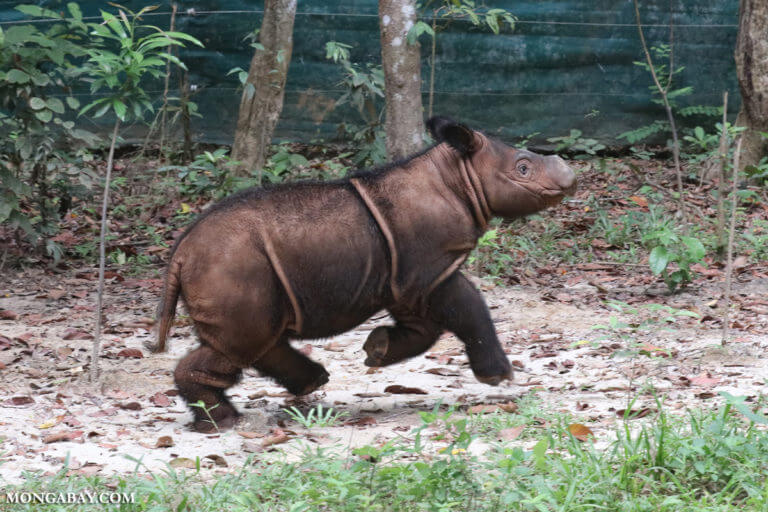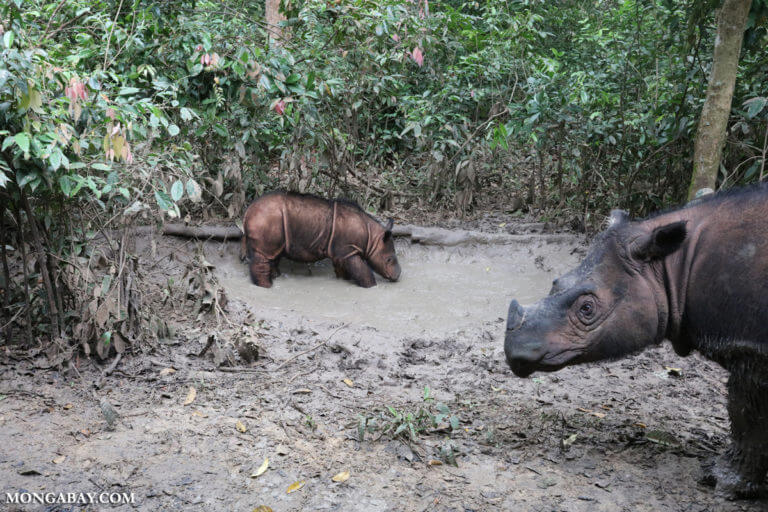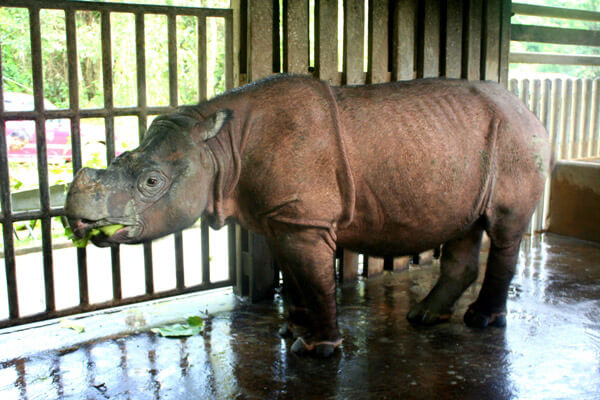LAHAD DATU, Malaysia – The rhino breeding center near the entrance to Danum Valley Conservation Area sits like an oasis of calm against the cacophony of beeps, woots and zaps of the surrounding jungle.
So calm it’s eerie, in fact. No one is working on the grounds. There are no animals in the collection of holding pens and chutes. Despite a few spots of rust, the green paint shows none of the wear that would have come with housing cow-size animals. A silent generator sits in the corner, and the whole area is surrounded by heavy cable fencing that’s never been tested.
On a side of the road sits a sign that reads, “THE DANUM VALLEY BORNEO RHINO SANCTUARY, DVBRS.” The text explains that I’m looking at the site of the breeding program for the Bornean rhinoceros, but a parenthetical below notes, “THERE IS NO RHINO IN CAPTIVITY AS YET.”
In the three years since the center’s construction not far from the town of Lahad Datu, the Bornean subspecies (Dicerorhinus sumatrensis harrissoni) of the Critically Endangered Sumatran rhino (Dicerorhinus sumatrensis) has only grown more elusive. Most experts agreed in 2015 that the only ones still living in Malaysia were the three captive rhinos in an enclosure at Tabin Wildlife Reserve, east of the town of Lahad Datu. Sadly, that number is down to two: Puntung, a 25-year-old female captured in Tabin in 2011, had to be euthanized in early June, shortly after being diagnosed with terminal cancer.
Puntung, a female Sumatran rhino at Tabin Wildlife Reserve in April. Her caretakers discovered that she had cancer in April, which caused a serious abscess in her jaw. Photo courtesy of the Sabah Wildlife Department.
I’d come to Danum Valley in part to follow up on a revelation that one more rhino might still be lumbering around the valley’s old-growth forests. In 2016, a team of scientists announced that they had found something resembling a rhinoceros print in the 438-square-kilometer (169-square-mile) reserve. It touched off a flurry of speculation – mostly by journalists like me – that a remnant population of rhinos may be hiding out in Danum.
But since learning of the possibility, I hadn’t been able to find anyone to tell me more about what it might mean. During a recent trip to Sabah, the WWF scientist who led the expedition turned down my request for an interview. And others scoffed at my naïveté when I brought up the “discovery.”
Footprint or fabrication?
In fact, it seemed that many conservationists believe that this apparition – this potential figment that could have just as easily been from a small elephant as from Borneo’s diminutive, shaggy rhinos – could actually be a detriment to the species’ survival, rather than a sign of hope.
The footprint, publicized at a press conference, crystallizes a decades-old struggle over how best to ensure the survival of these animals. Should managers do all they can to maintain wild populations? Or should they gather the surviving holdouts and help them reproduce?
Those in the latter camp write off the print as a myth that’s skewing the focus – and funding dollars – of conservation away from where it should be.
“The ‘rhino’ is a fabrication,” John Payne told me in an email. “[People] keep doing that.”
A biologist with decades of research and conservation experience in Borneo, Payne took the helm of SOS Rhino, a conservation group now known as BORA, short for the Borneo Rhino Alliance, in 2009. BORA is focused on saving the Sumatran rhino through an intensive breeding program based at the facility in Tabin.
“There are no wild rhinos left in Malaysia,” he added.
In Payne’s view, such a highly publicized whiff that there might still be hope for wild rhinos in Malaysian Borneo is misleading. A single animal banging around the brush of Borneo means little to the long-term survival of the species, especially given the species’ failure to recover even in protected areas like Danum Valley.
With one or two exceptions in Indonesia, rhino populations just aren’t large enough to harbor the level of genetic diversity necessary for their long-term survival, said Muhammad Agil, a veterinarian and faculty member at Bogor Agricultural University in Indonesia. Once a group dips below 15 individuals, it’s no longer a viable population, Agil said.
The science also seems to indicate that that isolation could lead to reproductive problems.
Those facts should be guiding conservation efforts away from observation of the existing wild rhinos, Agil told me, with fewer than 100 animals scattered throughout the Indonesian forests of Sumatra and Kalimantan in Borneo.
“We don’t need to do surveys anymore,” he said. “We need to do search and rescue for the rhinos.”
The goal of such missions is to bring the animals into an intensive breeding program employing assisted reproductive technology, such as artificial insemination and the harvest of females’ eggs, as the only hope for the most endangered rhinos in the world.
Keeping wild animals wild
The push for intensive breeding isn’t new. Intensive breeding programs that began in the 1980s with 45 individual rhinos have only led to five live births in captivity, and three of those occurred far from the jungles of Southeast Asia at the Cincinnati Zoo in the United States.
But the broader strategy of helping Sumatran rhinos to reproduce hasn’t been immune from criticism. Critics argue that the substantial cash outlay required to keep rhinos in captivity and carry out techniques such as in vitro fertilization would have been better spent on protecting animals in the wild.
More than 20 years ago, Alan Rabinowitz, then a biologist with the Wildlife Conservation Society, strongly opposed the use of finite resources for captive breeding. At the time, Rabinowitz wrote in an essay in the journal Conservation Biology that “viable populations” of rhinos still existed in Borneo and deserved protection. He argued that captive breeding efforts didn’t address the hunting and habitat loss that nearly wiped out rhinos in the first place.
Then, in 2012, Rabinowitz, currently the CEO of the big cat conservation group Panthera, questioned the endgame for captive rhino breeding when threats to wild rhinos still exist for a news story in the journal Nature. That viewpoint still guides many of the rhino conservation efforts, said ecologist Petra Kretzschmar at the Leibniz Institute for Zoo and Wildlife Research in Berlin.

“Today, the main strategy to help save the Sumatran rhinos is protection,” Kretzschmar said. Many funders want to see their money go to protecting wild populations – just as Rabinowitz argued for in 1995 – because they see that as the priority.
But, “It’s not,” Kretzschmar said. “Protection of the habitat is important, but it will not save the species.”
Beyond protection
The idea of keeping rhinos in the wild fits with the ethos of conservation, to keep as many wild animals as possible roaming around their natural habitats, subject to no outside mastery other than their own whims. And perhaps that’s why news that someone found a print is so intoxicating.
I certainly took a sip of that wine, even as the scientists I spoke with told me I might as well be chasing a unicorn. It’s a scene many of us dream of: stumbling upon a remnant of one of the world’s rarest animals, standing healthy and virile in the forest as its ancestors have in Southeast Asian rainforests for millions of years.
If there was anywhere in Malaysian Borneo rhinos would be, I thought, it seems that Danum Valley would be the place, a reserve that some of the world’s most seasoned tropical ecologists speak of only in hushed tones. Imagine flipping through a time-lapse series of rainforest photographs where you can watch the stepwise creep of the vegetation skyward in a slow-motion race for sunlight. It’s a punishing competition, and the decaying biomass all around leaves little doubt about what happens to the losers.
Big animals themselves in the forest are elusive. Within half a kilometer of the Danum Valley Field Centre, however, my guide Dedy points out the fresh mud wallows of boars from the night before and, in another spot, a pungent mix of dung, tracks and broken branches – souvenirs from their recent brush with an elephant herd moving up a creek bed.
Never mind that the ephemeral 700-kilogram (1,500-pound) animal left behind no other signs. And it still seemed unlikely that a rhino would escape the notice of the roughly 100 scientists working in the conservation area at any given time. That absence of a rhino sighting in Danum Valley since 2014 has been misinterpreted, BORA’s John Payne said.
“They think that not finding them means they’re not easy to find,” he told me when we met in Kota Kinabalu, Sabah’s capital city. “They’re easy to find.”
And the wild population’s downward spiral may have been beyond the help of conventional, protection-centered conservation for decades, Payne said, adding, “It should have been blindingly obvious that no rhino populations were demographically viable 50 years ago.”
The decimation of Borneo’s rhinos
Beginning in the 1930s, people started hunting the Bornean subspecies. Unlike their African cousins, which were (and have continued to be) a favorite quarry of foreign hunters, rhinos in Borneo were targeted from the outset by locals to fuel – then as now – the trade of rhino horn going mostly to China.
It wasn’t long before someone figured out that the island’s rhinos couldn’t withstand this kind of pressure. As early as the 1980s, scientists sounded the alarm that rhinos were at risk of being wiped out and that we needed to eliminate the threats to their survival.
But when conservationists began working to staunch poaching and rhino habitat loss, the numbers didn’t rebound the way that other rhino species had under similar protections, Kretzschmar said, who works in rhino conservation all over the world. Today, Africa’s southern white rhino (Ceratotherium simum simum) stands as a testament to the success of earnest protection: Hunting slashed the population to no more than 100 animals by 1895, but today there are more than 20,000.

The Sumatran rhino has followed a different path.
In small populations, maintaining genetic diversity is a concern of course, but so is the chance that they’ll bump into each other. With so few rhinos, “There’s only little chance for the individuals to meet each other,” Kretzschmar said.
This reality seems to be particularly true on the island of Borneo. For all of the spectacular life it supports, the number of large animals Borneo supports is relatively meager. A landmark study in the 1980s revealed that the island’s soils don’t pack the same levels of nutrients found elsewhere in Southeast Asia, and subsequent research postulated that this difference crimps the numbers of big mammals that can survive on the island.
The behavior of Borneo’s rhinos doesn’t seem to have helped the species out very much either, especially as those numbers continued their downward trajectory. As far as we know, they like to keep to themselves, and the desire to breed doesn’t seem to convince them to push those boundaries of solitude.
“It’s all preprogrammed inside them that they will not go beyond their territory to look for a mate,” said Zainal Zahari, a veterinarian with BORA.
In more than 30 years working alongside these animals, he is well-versed in the quirks of Sumatran rhino biology. He and other rhino biologists believe that this isolation, caused first and foremost by the decimation of the species at the hands of hunters and the loss of their forest homes throughout much of the 20th century, has not only whittled away the diverse gene pool that keeps animals healthy. It has also kept the rhinos from finding each other. They think that it has caused the tumors in the females’ reproductive tracts that have thus far made successful captive breeding such an elusive outcome.
The issue may have to do with the animals’ own biochemistry. Female rhinos continue to cycle through estrus whether there’s a bull around or not. If they don’t copulate, biologists think that the “hormone overload” during this time in their cycles, which would ordinarily prime them for pregnancy, might actually be causing these reproductive problems, according to research that identified similar problems in Indian rhinos (Rhinoceros unicornis).
All of these issues mean that the remaining rhinos have little chance of reproducing on their own. Right now, in Indonesia, more wild rhinos could be captured and brought into breeding programs, such as the Sumatran Rhino Sanctuary in Way Kambas National Park, where two rhinos have been born in captivity.
Rhinos without borders
Zahari notes the tensions that come with working across international borders.
“There is still distrust,” he said. “There is still patriotism.”
Still, BORA’s staff there wants to share what they’ve learned with Indonesia for the sake of the species. The team has made a lot of progress in their understanding of how to keep these animals healthy, he said.
Kretzschmar and Zahari were both heartened by a recent meeting of rhino conservationists in Jakarta, during which the Indonesian government signaled an openness to using artificial insemination, Kretzschmar said.
Muhammad Agil said that a team in Indonesia was poised to share semen collected from one of its captive bulls with BORA in Sabah, once approval from the Indonesian government comes through. They also hope to receive semen from Tam, a bull kept at Tabin. Agil said this sort of sharing between sanctuaries was essential to maintain the genetic diversity of the few Sumatran rhinos left.

He also reported a better understanding of the fact that scientists, NGOs and governments can no longer keep their efforts to themselves. “It will be more valuable and the success rate will be higher if we can get all of the experts to work together,” he said.
As Kretzschmar told me before the conference, “The most critical and important point to save the Sumatran rhino comes down to communication – communication between governments, but also between organizations.” And everyone needs to come together to pull the animal from the claws of extinction.
“It should be one management plan,” she added.
If the rhino conservation community cannot find a way to share these lessons, “They will make the same mistakes that Sabah did,” Zahari said. “Then the story stops there.”
Now, acting quickly is as important as the willingness on both sides to bring the animals together and create one breeding program to save the species.
“Numbers are dropping,” Kretzschmar said, “and if there is not a speed-up in the process, the whole species is going to be extinct in the next 10 years.”
Payne laments that a single program to save the Sumatran rhinoceros “should have been done years ago.” Like a relic to that missed opportunity, the rhino sanctuary in Danum Valley sits unused, and it seems unlikely that a rhino will ever make its way through the gates there.
The center also represents an obsolete way of thinking, that there should – or could – be separate breeding programs for this imperiled species. Paradoxically, such places, built expressly for the preservation of the species, might create the same conditions that spurred the need for them in the first place.
“It doesn’t help if we have [multiple] breeding centers” that aren’t working together with just a few animals in each, Kretzschmar said. “Then we have isolated populations again.”
Read the full article on Mongabay